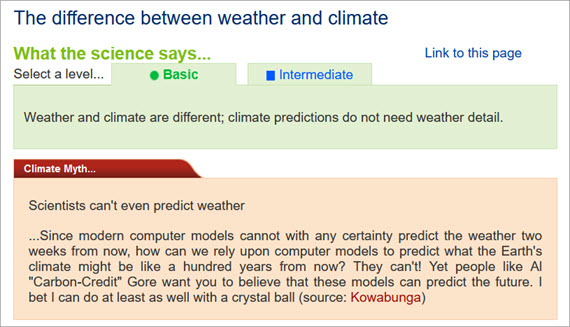
On February 14, 2023 we announced our Rebuttal Update Project. This included an ask for feedback about the added "At a glance" section in the updated basic rebuttal versions. This weekly blog post series highlights this new section of one of the updated basic rebuttal versions and serves as a "bump" for our ask. This week features "The difference between weather and climate". More will follow in the upcoming weeks. Please follow the Further Reading link at the bottom to read the full rebuttal and to join the discussion in the comment thread there.

How do you go about weather forecasting by yourself? Study the computer models. With experience, you will become familiar with the art - for it takes human interpretation of model output to make the calls. That's what weathermen do.
Forecast model output is freely available online and covers many parameters - pressure, temperature, rainfall and a myriad of others. Different models extend to different end-times - the Global Forecasting System (GFS) extends to T+ 384 hours or 16 days, for example. Pressure, or synoptic charts as they are known, portray the positions and subsequent developments of high and low pressure systems over large swathes of the planet.
Models are run several times a day. If you examine synoptic charts for the same run of several different models, you will see they all look very similar to start with. But if you then follow them through successive time-points - T+24, 48, 72 hours and so on, there will come a point where you start to notice slight and then larger differences between them. This divergence is where confidence in forecasting falls right away.
Forecasting - interpreting the GFS and other model output - is about working with uncertainty in the highly dynamic and to an extent chaotic medium that is our atmosphere. But with experience, you can do your own short term forecasting too, at least for the coming 3-5 days.
Longer-term weather forecasting a week or more in advance is about stating probabilities, not saying what will happen. Very different things. Serious amateur forecasters stick to the shorter, next few days bracket, if they want to avoid egg on their faces. There are a few out there who often make wild claims that usually fail to be borne out by reality. Unfortunately, sections of the more populist media happily quote them. It generates click-baity headlines.
Now, what about climate? Climate differs from weather because it includes certain highly deterministic drivers. Deterministic means they evolve independently of weather but can change the physical conditions on Earth from state A to state B. Cyclic variations in Earth's orbit of the Sun, operating over tens of thousands of years, are a good example. They may only drive average planetary temperature changes of a few degrees Celsius, upwards or downwards. But with the help of climate feedbacks, that is enough to have caused past ice-ages - and to have gotten us out of them again.
Changes in the strength of Earth's greenhouse effect are likewise deterministic, but to a far greater extent. They have forced past transitions from the Hothouse to the Icehouse climate state. Hothouse, by the way, is an ice-free Earth. Because we know how the greenhouse effect works, we can say with confidence that intensifying its strength will cause global temperatures to rise over centuries. What we cannot say is what weather will occur on a certain day at a certain place, decades from now. But there's a handy saying to cover that: "climate trains the boxer, but the weather throws the punches". (Deke Arndt, Climate Monitoring Branch Chief, NCDC, 2010)
Please use this form to provide feedback about this new "At a glance" section. Read a more technical version below or dig deeper via the tabs above!
In case you'd like to explore more of our recently updated rebuttals, here are the links to all of them:
If you think that projects like these rebuttal updates are a good idea, please visit our support page to contribute!
Posted by John Mason on Tuesday, 23 April, 2024
 |
The Skeptical Science website by Skeptical Science is licensed under a Creative Commons Attribution 3.0 Unported License. |